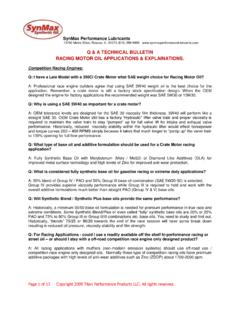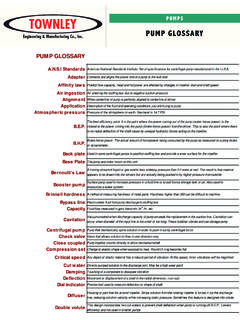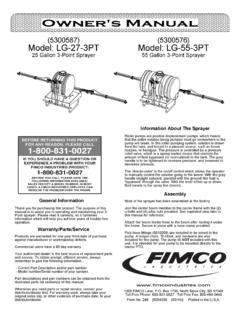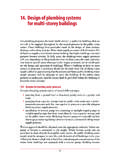Transcription of GREASE OVERVIEW & APPLICATION PRESENTATION
1 GREASE OVERVIEW & APPLICATION PRESENTATION WHAT IS A GREASE A GREASE is a solid-to-semifluid product of dispersion of a thickening agent in a liquid lubricant. Other Ingredients imparting special properties may be included. (ASTM D288) Commonly referred as a sponge that holds the lubricant When the sponge is squeezed (worked) the lubricant and its additives are released. Lubricating oils and additives are the major constituents in a GREASE FACTS Greases have been in use since Ancient Times The first greases were made from animal fats and pitch. The Ancient Egyptians made GREASE from animal fats, resins and lime. This was the first calcium base GREASE ever made. The first EP and ant-wear agents used consisted of sulfur, lead powder, graphite and antimony. Lithium, barium and aluminum soap base greases started to be used in the 1920 s and 1930 s. By the 1940 s and 1950 s the first complex base greases MARKET DISTRIBUTION BY THICKENER TYPE US MARKET50%15%9%6%1%5%1%3%3%1%6%Li SoapsLi ComplexCa SoapsCa ComplexCa SulfonateAluminum ComplexSodium SoapsOther SoapsPolyureaBentoneOther Nonsoap Thickeners Copyright 2000-2001 NoriaCorporationAnatomy of a Lubricating GreaseAnatomy of a Lubricating GreaseRef.
2 JCF961 - Mineral oil - Synthetic oil - Simple metal soaps - Complex metal soaps - Non-soap thickeners - Enhance desirable properties - Suppress undesirable properties - Add new propertiesGREASE MANUFACTURING PROCESSLONG CHAIN FATTY ACID(12-hydroxysterarte)SIMPLE SOAP (Saponification)+Metal Hydroxide(Li, Na, Al, Ca)Metal SoapBase ChargeHeatingMixingGREASE MANUFACTURING PROCESSC omplex Soap (co-crystallization)Long ChainFatty Acid(stearicacid)+Short ChainOrganic Acid orInorganic Salt(benzoic acid)+Metal Hydroxide(Li, Ba, Al, Ca)Complex Metal SoapBase ChargeHeating MixingGREASE MANUFACTURING PROCESSG rease FinishingComplexMetal Soap+BaseOil+AdditivesHeating, CoolingAnd MixingGreaseGreaseColloidal MillPackagedGreaseADVANTAGES OF MILLING A GREASE The Milling Process is a shearing process. Process and equipment used is similar to the process used to homogenize milk The GREASE is pumped under pressure between a stationary and a rotary member (stator and rotor) that have very fine clearances (.)
3 001 to .005 of an inch). Breaks up agglomerates and disperses the thickener and additives such as solid lubricants thoroughly throughout the GREASE . Results in a thicker GREASE product that has less thickener content. Results in a GREASE that is more mechanically shear stable. Improves the consistency of a GREASE . Improves the resistance of the GREASE to bleedingGrease kettle is charged first with the fatty acids, short chain acids, alkali and a portion of the base oil. The saponification reaction is carried out by at temperatures between 185to 195 FHeating is continued with mixing to 385to 395 FThe batch is then cooled through the use of heat exchangers and then transferred to the finishing kettle after it has been allowed to cure for 24 to 48 hoursFUNCTION OF A GREASE Reduce friction and wear in the machine element being lubricated under various operating conditions. Protect against rust and corrosion. Prevent dirt, water and other contaminants from entering the part being lubricated.
4 Maintain its structure and consistency during long periods of use. Permit free motion of moving parts at low temperatures and pump freely at those temperatures. Have suitable physical characteristics for the method of APPLICATION and retain those characteristics during storage. Be compatible with Elastomer seals and other materials associated with the parts being lubricated. Tolerate or resist some degree of moisture contamination without significant loss of performance. WHEN TO USE A GREASE When oil can not be confined. When relubrication is difficult or dangerous. When the lubricant is required to exclude contaminant ingression. When equipment design specifies a GREASE . When it is required to reduce time spent lubricating. When it is required to reduce relubrication frequency. For equipment used intermittently. For extreme conditions of :-High Temperature-High Pressure-Shock Loads-Low speed combined with high loadsWHEN TO USE A GREASE When it is required to suspend solid additives.
5 For machinery parts that experience severe wear. When noise reduction is OF GREASE LUBRICATION Better Stop-Start Performance When the system shuts down, oil drains away while GREASE remains in the component. Squeeze Film Lubrication-Under vertical loading conditions, GREASE acts as an elastic slide to provide enhanced lubrication. Sealing Problems Surplus GREASE acts as an effective sealant. Contamination The risk of contamination products such as food and pharmaceutical type products is reduced with the use of GREASE due to its resistance to flow into the OF GREASE LUBRICATION Supply of Surplus Lubrication The semi-solid nature of GREASE enables it to be fed easily into spaces around the working surfaces. Lubricated On the Run A machine filled with greasing valves can be relubricated on-the run without shutting down the machine or interrupting OF GREASE LUBRICATION Reduced Cooling/Heat Transfer The flow of oil removes heat from the point of generation where it can be removed or dissipate.
6 GREASE tends to hold heat in place. Bearing Speed Limitations The high effective viscosity of GREASE imposes speed limitations on bearings to avoid excessive heat generation. This problem is worsened by GREASE s poor heat transfer properties. Poorer Storage Stability - GREASE are less stable than oils when stored under the same conditions. To long of storage can lead to separation of base oil and thickener and altered propertiesDISADVANTAGES OF GREASE LUBRICATION Lack of Uniformity Due to poor predictability of the batch process of greasemaking and the added variability associated with the thickener, uniformity of greases tend to be inferior to that of oil. Compatibility The user must be careful about thickener compatibility of greases. In many cases, the compatibility is poor. Lower Resistance to Oxidation The effects of oxidation products on the the stability of thickeners makes GREASE more susceptible to OF GREASE LUBRICATION Contamination Control Oil lubricants suspend and transport particle to filters and allow particles to settle under the force of gravity.
7 GREASE lubricant suspend particles, continuously subjecting component surfaces to their abrasive effects. Difficult Volume Control The difficulty in gauging the proper quantity of GREASE to add, especially during relubrication, leads to frequent over and under OF GREASE Soap Base GREASE Complex Soap-Formed by the joint reaction of an active metalhydroxide with a fatty acid and a organic acid ( benzoic acid) or an inorganic salt. This process isknown as co-crystallization. Non-Soap Base Greases-Formed from either inorganic thickeners or organic thickeners (polymeric type)-Bentone-Silica Gel-Polyurea-Calcium SulfonateALUMINUM COMPLEX BASE GREASES Low thickener content of to by weight Smooth and buttery texture Dropping point of 4000F-5000F (2040C to 2600C) Maximum usable operating temperature of 3500F-spot temperatures of 4000F (1770C to 2040C) Excellent resistance to water washout. Slightly hardens in consistency in the presence of water. Very good to excellent resistance against rusting, especially in the presence of moisture Very good to excellent work stability Very good to excellent mechanical and shear stability.
8 Slightly to moderate hardening in consistency when subjected to high shock loading and severe shear stresses. Very good to excellent oxidation stabilityALUMINUM COMPLEX BASE GREASES 95% to 100% Reversibility Excellent pumpability Compatible will all types of greases except bentone base greases Excellent versatility. Can be used in a wide range of applicationsBARIUM SOAP BASE GREASES Very high thickener content. Up to 35% by weight Fibrous and stringy in texture Dropping point of 3700F to 4000F Maximum usable temperature of 2500to 2850F Very good resistance to water washout Fair to good protection against rusting Good work stability Fair to good shear and mechanical stability. Will separate into its base oils and thickeners when high to severe mechanical shear stresses are encountered. Fair resistance to oil separation Poor Reversibility. 0% to 30% Reversibility Poor pumpability, especially at low temperatures Possibility that compounds containing barium are highly toxicBARIUM COMPLEX SOAP BASE GREASE Very high thickener content of 20-30% by weight Fibrous and stringy in texture Dropping point of 3800F-4000F (1930C to 2040C) Maximum usable operating temperature of 2850F-3000F (1410C to 1490C) Highly water resistant Fair to good protection against rust, especially in the presence of moisture Good work stability Fair to good shear and mechanical stability.
9 Will separate into its base oils and thickeners when high to severe mechanical shear stresses are encountered. Fair resistance to oil separation Poor Reversibility. 0% to 30% Reversibility Poor pumpability, especially at low temperatures Possibility that compound containing barium are highly toxicBENTONE BASE Low to relatively high thickener content 6-15% by weight Smooth to buttery texture No dropping point Maximum usable temperature of 3500F to 7000F(1770C to 3710C) The maximum usable temperature is dependent upon the quality and type of base oil used in the formulation of the GREASE and its re-lubrication cycle. Fair to excellent water resistance. The lower the thickener content the better the water resistance Good to excellent protection against rusting in the presence of moisture Good to very good work stability Good to very good shear and mechanical stability. Depends upon the thickener content Good to very good low oil separation characteristics. Moderate to very good Reversibility.
10 50% to 95%. Good to very good oxidation stability Good to very good pumpability Not compatible with any types of soap base greases and polyurea base SOAP BASE Relatively high thickener content 12-20% by weight Smooth and buttery texture The least expensive GREASE to manufacture Dropping point of 2050-2200F Maximum usable operating temperature of 1950F Fair to good resistance to water washout Poor to fair protection against rust in the presence of moisture Fair to good work stability. Will soften in consistency when severely worked in a bearing Fair to good mechanical shear stability Water is an essential ingredient in the process used to compound this GREASE . If the water evaporates at high temperatures, the GREASE will rapidly separate into base oil and thickener. Poor to good oxidation stability Good pumpability Poor reversibility. 5% to 30% Reversibility CALCIUM 12-HYDROXYSTEARATE GREASES Relatively high thickener content 10-15% by weight Smooth and buttery texture Dropping point of 2750to 3000F Maximum usable operating temperature of 2300F Good to very good water resistance Poor to very good protection against rust in the presence of moisture.







